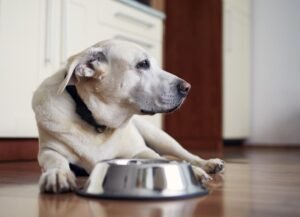It starts with a stare, then maybe a whimper, and usually involves big, sad puppy dog eyes. You’ve got a few leftover carrots on your plate, and your dog looks so adorable that you can’t help but share one with him.
While giving your dog occasional, safe “people food” is often fine from a canine nutrition standpoint, the behavior that might come with sharing your food can become a nuisance.
Once a dog understands that what’s on your plate can be his with enough requests, you might find yourself in a constant mealtime beg-fest. A dog who begs for food—or worse, demands it—isn’t fun to be around.
But a begging habit isn’t set in stone. You can convince your dog to stand down at mealtimes—or better yet, prevent the puppy begging behavior from even starting.
Why Do Dogs Beg?
For dogs, food is a primary reinforcer. Just the presence of food can be so strong that a dog will immediately try to get it. Dogs’ incredible sense of smell means they can sniff out nearby food—and they aren’t likely to understand that your steak dinner isn’t meant for them.
Dogs can also learn where and how to get food, thus developing the begging behavior.
How To Stop a Dog From Begging
If your dog lurks under the table, whines, paws, or barks at you while you eat, there are steps you can take to end these behaviors.
1. Teach a Replacement Behavior
Teaching a dog to settle in a designated spot, like on a mat or in their dog bed, is an incredibly useful skill.
Ask your dog to lie down in his place during your mealtimes. As you eat, give your dog a treat every so often as he remains lying down and relaxed. Keep his mat or bed close to the table so you don’t have to get up to reward him.
Over time, increase the time between treats until your dog can relax for the entire meal. You’ll eventually reach a point where he’s happy receiving one treat when he initially lies down and one at the end of your meal.
At this point, you can move his mat farther from the dining table.
2. Keep Them Occupied
Keeping your dog busy while you eat will shift the focus from what’s out of reach on your plate to what’s right in front of his nose.
First, consider feeding your dog at the same time you have dinner. Divide their food into several food-dispensing toys—these will give your dog a job and keep him happily occupied. You can also combine dry and wet food options with the right food toys.
Consider using a food toy that requires movement to dislodge the kibble, like a ball with holes your dog must push around the room. This will keep him away from your food area while you eat. For wet food, you can use a lick mat or lick bowl.
3. Give Yourself Some Space
If your begging dog tries to get too close to you while you eat (like placing his nose in your lap), it’s important to keep him away. Put your training to work and try a long “stay” with him a few feet away from the table.
If your dog is comfortable in his crate, give him food toys inside of it when you eat. You can also use a pen, which will allow him to enjoy his own food-related activities—and keep him away from the table.
4. Ignore the Begging
If you choose to ignore your dog, be aware that he might go through what’s known as an “extinction burst,” as he tries to get his formerly successful begging techniques to work. This means your dog will whine louder, paw harder, pace faster, and bark louder because those tricks got him table scraps in the past.
Do not give in to this behavior. If you break down and give your dog food when he escalates his requests, he’ll learn that you’ll give him food if he pushes hard enough. But if you continue to ignore him, he will eventually stop his dog begging behavior.
Because of this, it might be better to teach your dog a replacement behavior or keep him occupied with toys so he doesn’t become stressed, frustrated, and confused.
How To Prevent a Dog From Begging
Some dogs seem to be born beggars, while others learn the skill. If you’ve got a puppy or a new rescue dog, you can prevent a begging habit from starting by following one simple rule: Don’t feed your dog from your eating area.
Context is important when it comes to dog begging behavior. If your dog understands that food on your plate eventually means food for him, he will view that context as mealtime for two.
Keep in mind that a begging habit can also develop when you share snacks on the go, like when you’re standing at the counter eating a few chips. If your dog demands some and you give in, you’ve taught him that begging works any time you’re eating.
A treat-filled toy can also help prevent puppy begging in the first place. Keep in mind that you’ll have to pack the toy so it maintains your dog’s attention throughout your meal. A single treat will disappear in minutes, but a toy layered with special treats like frozen peanut butter, mushed-up bananas, or even just a portion of his meal ration will hold his attention until you’ve finished.
Tips for Sharing Food With Your Dog
In general, sharing dog-appropriate food with your dog is OK in moderation. If you are careful about when and where you share, you can avoid creating begging habits.
But too many table scraps, especially foods that are high in fat, nitrates, and other components that are also unhealthy for humans, can lead to health problems such as obesity, pancreatitis, and others.
If you can’t resist sharing dog-healthy food with your pup on occasion, there is a way to do it without encouraging an obnoxious begging habit.
Teach your dog to go to a specific spot and wait quietly until you’re ready to offer him a taste. This lesson encourages impulse control and shows your dog that he doesn’t have to be right on top of you and acting pushy to get a bite.
For example, using the mat and settling skill will help your dog wait patiently until you’re ready to give him a bit of apple or that last nibble of broccoli. That way you’re both happy; your dog gets his goody, and you get a polite dining companion.
Remember to keep portions of shared food small. Ninety percent of a dog’s daily calories should come from a well-balanced dog food; treats should never make up more than 10% of their diet.




